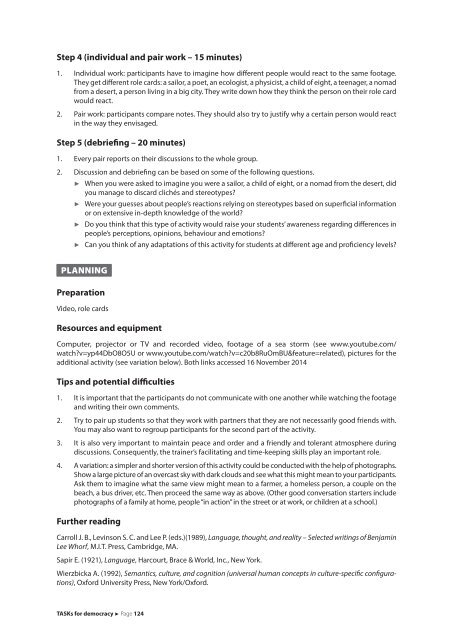TASKs for democracy
4NYw4W
4NYw4W
Create successful ePaper yourself
Turn your PDF publications into a flip-book with our unique Google optimized e-Paper software.
Step 4 (individual and pair work – 15 minutes)<br />
1. Individual work: participants have to imagine how different people would react to the same footage.<br />
They get different role cards: a sailor, a poet, an ecologist, a physicist, a child of eight, a teenager, a nomad<br />
from a desert, a person living in a big city. They write down how they think the person on their role card<br />
would react.<br />
2. Pair work: participants compare notes. They should also try to justify why a certain person would react<br />
in the way they envisaged.<br />
Step 5 (debriefing – 20 minutes)<br />
1. Every pair reports on their discussions to the whole group.<br />
2. Discussion and debriefing can be based on some of the following questions.<br />
<br />
<br />
<br />
<br />
When you were asked to imagine you were a sailor, a child of eight, or a nomad from the desert, did<br />
you manage to discard clichés and stereotypes?<br />
Were your guesses about people’s reactions relying on stereotypes based on superficial in<strong>for</strong>mation<br />
or on extensive in-depth knowledge of the world?<br />
Do you think that this type of activity would raise your students’ awareness regarding differences in<br />
people’s perceptions, opinions, behaviour and emotions?<br />
Can you think of any adaptations of this activity <strong>for</strong> students at different age and proficiency levels?<br />
PLANNING<br />
Preparation<br />
Video, role cards<br />
Resources and equipment<br />
Computer, projector or TV and recorded video, footage of a sea storm (see www.youtube.com/<br />
watch?v=yp44DbO8O5U or www.youtube.com/watch?v=c20b8RuOmBU&feature=related), pictures <strong>for</strong> the<br />
additional activity (see variation below). Both links accessed 16 November 2014<br />
Tips and potential difficulties<br />
1. It is important that the participants do not communicate with one another while watching the footage<br />
and writing their own comments.<br />
2. Try to pair up students so that they work with partners that they are not necessarily good friends with.<br />
You may also want to regroup participants <strong>for</strong> the second part of the activity.<br />
3. It is also very important to maintain peace and order and a friendly and tolerant atmosphere during<br />
discussions. Consequently, the trainer’s facilitating and time-keeping skills play an important role.<br />
4. A variation: a simpler and shorter version of this activity could be conducted with the help of photographs.<br />
Show a large picture of an overcast sky with dark clouds and see what this might mean to your participants.<br />
Ask them to imagine what the same view might mean to a farmer, a homeless person, a couple on the<br />
beach, a bus driver, etc. Then proceed the same way as above. (Other good conversation starters include<br />
photographs of a family at home, people “in action” in the street or at work, or children at a school.)<br />
Further reading<br />
Carroll J. B., Levinson S. C. and Lee P. (eds.)(1989), Language, thought, and reality – Selected writings of Benjamin<br />
Lee Whorf, M.I.T. Press, Cambridge, MA.<br />
Sapir E. (1921), Language, Harcourt, Brace & World, Inc., New York.<br />
Wierzbicka A. (1992), Semantics, culture, and cognition (universal human concepts in culture-specific configurations),<br />
Ox<strong>for</strong>d University Press, New York/Ox<strong>for</strong>d.<br />
<strong>TASKs</strong> <strong>for</strong> <strong>democracy</strong> Page 124


